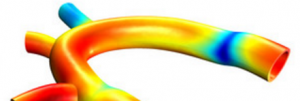Carbon fibers are typically used in fabrics or rovings. But they do not have to be. Engineers in Dresden, Germany, have developed a technology used to place the stable fibers precisely along the places that have to withstand the greatest load.
Stitching. Seating furniture. Couch cushion? Just red herrings. The trail leads to the Dresden engineers for high-tech applications who have brought stitching into their service: developed by Leibniz Institute of Polymer Research Dresden (IPF), the tailored fiber placement (TFP) technique can be used to manufacture components made of fiber-reinforced plastics. While being very lightweight, these components are capable of bearing heavy loads. The fibers are placed selectively in the places that will be subject to the most stress in the end product. Stitching is used to keep the fibers in the right place until they are fixed by the plastic matrix.
This technique may sound somewhat exotic, but it is in no way a purely academic affair: window frames for the Airbus A350 are already being made in this fashion. “And there is potential for a number of other applications,” says Dr. Axel Spickenheuer, who works on this subject at the Dresden Institute. Medical technology is one of the industries that may be able to benefit from TFP.
The first ideas on how reinforcement fibers could be placed anywhere in a component were discussed and worked out at the beginning of the 1990’s. The goal was to use the properties of fibers in a better way than what was possible with the known fabrics and rovings. In these materials, the fibers are usually in a fixed orientation, and it is the engineer’s job to try to dissipate the forces in the component by packing the cuts of fabric on top of one another with alternating fiber orientation.
Within a short amount of time, the engineers gathered evidence that this task would have a more elegant solution if the fibers were freed of the fixed pattern and placed on a substrate in curves and zig-zags, or simply put in any pattern. For the first attempts, the threads were sewn by hand, but the step to the automated, machine-reproducible procedure was soon to follow. Industrial embroidery machines can be used to place the fibers on a base material in the shape of curves, loops, bulges, and patterns based on the requirements of the component, and they can attach the fibers in 1,000 stitches per minute or less. This preform is then impregnated with the matrix material and can solidify through proper treatment. That is unless the fibers were originally hybrids (fibers that have been impregnated with the matrix material).
In this process, any combination of fibers and matrix materials are possible as long as it is adapted to the intended application; each has its own specific advantages and disadvantages. Common for all combinations is that the component ends up in a mold at the end where it will receive its final shape in the matrix and will assume the desired stiffness.
What the ideal fiber path was supposed to look like in each case was determined by estimations and optimized through trial and error. Meanwhile the computer plays a major role in the process. “Today,” says Spickenheuer, “we are working, for example, on developing software that will use the FEM data on the stresses in a component to calculate the right fiber paths while discarding the CAD data needed to produce a corresponding mold.”
These efforts are elemental in creating a s ituation in which this process can be used more often in industrial applications in the future. Even though there are companies among the IPF spin-offs that manufacture parts according to customer specifications or use fibers in a customized arrangement for special, specifically heatable tools, laying out the fiber paths, in particular, is an art with which few are familiar. For some years now, IPF has been developing special software that will eventually find its way into industrial application also.
The reason why this has not happened yet is partly because the demand for such tools has so far remained limited. “When using reinforcement fibers, most engineers first think about the classic woven half-finished products that have to be laminated,” admits Spickenheuer. Yet vertical structural stitching can be used to make sophisticated components such as a stool that weighs only 650 g and has no problem handling loads of up to 200 kg. The stool was developed as a demonstration model in a project that involved IPF engineers working alongside design students from Dresden University of Applied Sciences (HTWD). Manufacturing the stool out of woven half-finished products with the same design and load-bearing capacity would mean accepting about 20% scraps, and the stool would end up weighing about twice as much. “This is why the stool is such an excellent example of TFP’s potential,” says Spickenheuer. Not for nothing have the stools been on display as part of the “Hard Material” exhibit at Deutsches Museum Bonn since mid-September. The Leading-Edge Cluster MAI Carbon initiated the exhibition to show the public the possibilities that lightweight construction has to offer. The exhibition ran for one year in Munich as well and attracted 160,000 visitors.
The TFP technique can be used for more than just lightweight stools or applications in the automotive industry or in aeronautics and astronautics, however. “TFP has potential for use in biomedical implants such as cruciate ligament reconstructions or surgical meshes for hernia repair,” says Spickenheuer. The latter are currently woven. But the stress-strain behavior of the woven textiles does not always match exactly the stress-strain behavior of the human tissue in which it is implanted. Adapted fiber paths could help reduce the number of subsequent surgeries. Also, combining reinforced components with other elements produces results such as a very lightweight robot foot that contains much less components and weighs only half as much as its lightweight predecessor made out of aluminum. An elastomer joint can be installed and chemically bonded to the matrix. “We hope that these projects will give engineers ideas,” says Spickenheuer, “and we look forward to the discussion on where our technique can be used to bring the most benefit.”
Dr. Birgit Oppermann birgit.oppermann@konradin.de
Teilen:







